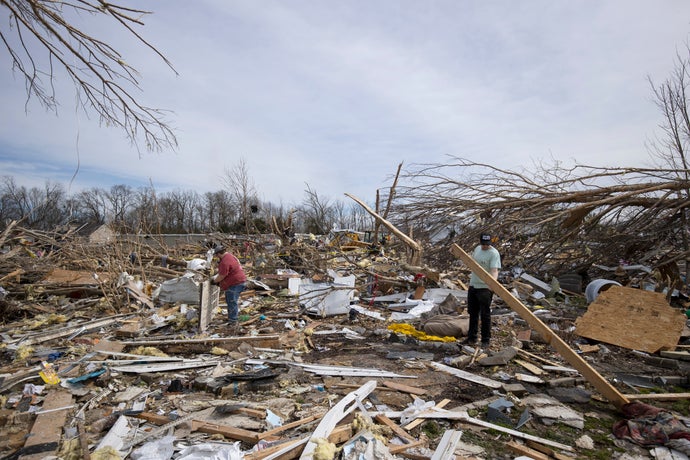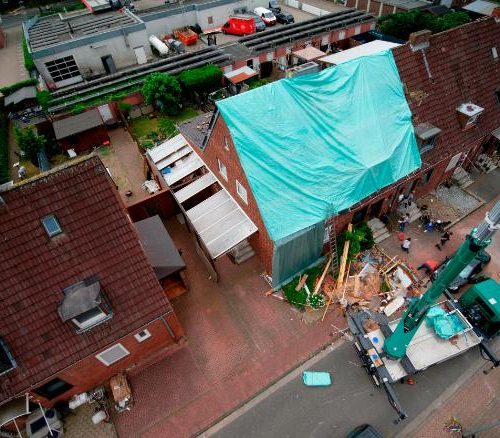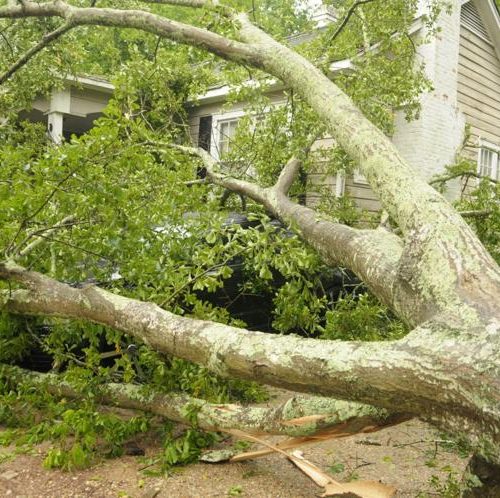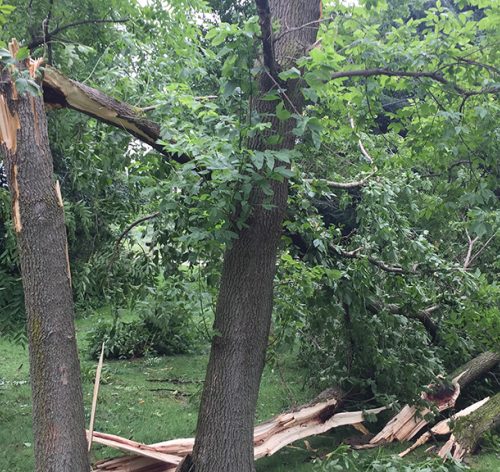In March 2019, a violent tornado plowed through eastern Alabama, flattening houses and demolishing mobile homes. Twenty-three people were killed including four children, ages 10, 9, 8 and 6.
Exactly one year later, on March 3, 2020, a tornado gusting at 170 mph ripped through central Tennessee, killing 19 people. Four of the victims were children between the ages of 2 and 7.
The twisters spiraled along the ground for only minutes, but they are the two deadliest natural disasters in the United States since the start of 2019. They received fleeting national attention.
The mortal storms illustrate an alarming trend that is overlooked amid concern about hurricanes, wildfires and floods: Tornadoes are increasingly occurring in the Southeast, where they are twice as deadly as tornadoes elsewhere in the United States, according to an E&E News analysis.
A shift of tornado activity from the Great Plains to the Southeast has brought heightened danger by concentrating twisters in a far more perilous landscape—one covered by forest that conceals tornadoes and is filled with mobile homes that are easily demolished.
During the 2019 Alabama tornado, 19 of 23 victims were killed in mobile homes. The state has the most recorded tornado deaths than every other state. It also has one of the nation’s highest concentrations of people living in mobile homes.
NOAA records dating to 1950 show that tornado activity has increased in the Southeast since the late 1990s and that the trend—and death toll—has accelerated in recent years.
“The number of killer tornadoes in the Southeastern U.S. is disproportionately large when compared to the overall number of tornadoes throughout the country,” NOAA says.
Since January 2019, 99 of the nation’s 120 tornado-related deaths occurred in the Southeast, NOAA records show. That’s 83%.
In the 2010s, 54% of tornado deaths occurred in the Southeast.
In the 1980s, 25% of the deaths were in the Southeast.
The Southeast includes Alabama, Arkansas, Georgia, Louisiana, Mississippi and Tennessee—an area some tornado analysts call “Dixie Alley.”
West of the Mississippi River, the Great Plains region known as “Tornado Alley” has become oddly safe.
Kansas, once the epicenter of tornado activity and home to the most famous tornado survivor in fiction, Dorothy Gale, has not had a tornado death since Feb. 28, 2012.
Nebraska hasn’t had a tornado death since June 16, 2014, and has had only five tornado deaths in the past 32 years.
Iowa has had only three tornado deaths since June 2008.
Throughout Tornado Alley, there have been only 24 tornado deaths since the start of 2016, NOAA records show. The region includes Iowa, Kansas, Missouri, Nebraska, Oklahoma, South Dakota and Texas.
“There’s definitely been a spatial redistribution of tornadoes,” said Purdue University climate scientist Ernest Agee.
Agee’s 2016 study in the Journal of Applied Meteorology and Climatology concluded that Alabama and Tennessee had replaced Oklahoma as “the modern-day center for annual tornado activity.”
‘THE SHIFT IS REAL’
The shift has raised scientific questions, particularly about the influence of climate change and whether tornadoes in the Southeast have unique traits that make them more perilous, such as a propensity to strike in the middle of the night.
Studies have suggested possible links between global ocean temperatures and U.S. tornadoes but are inconclusive about the effect of climate change. Tornado activity is difficult to link to climate change because tornadoes are small and spontaneous compared with hurricanes and cannot generally be produced in large-scale climate models.
“Whether tornadoes are driven by trends in climate still needs more research,” said Christopher Nowotarski, a tornado researcher at Texas A&M University.
Yet as tornado deaths shift to the Southeast, some scientists scorn efforts to understand the reasons for their redistribution. They say research should instead focus on social science—finding ways to protect people through measures such as stronger building codes and public education about tornado danger.
“The shift is interesting from a scientific perspective. But the cause does not matter,” said Northern Illinois University professor Victor Gensini, a leading tornado researcher. “The reality is, we have people in these [Southeastern] regions who are way more vulnerable. The shift is real, and it’s putting a lot more people at risk.”
The hard-science-versus-social-science split mirrors a divide in climate research between experts focused on slowing climate change and advocates of adaptation strategies such as coastal retreat to protect people from rising sea levels.
The shift of deadly tornadoes prompted NOAA to launch a research program in 2016 to study how the Southeast’s environmental factors affect tornadoes and their formation, intensity and paths. The program, called VORTEX-SE, is an offshoot of a program NOAA began in 1994 to determine how tornadoes form.
One goal of VORTEX-SE is to improve forecasts and warnings, which are notoriously problematic. Tornado warnings typically go out just 15 minutes before a strike, and many turn out to be false alarms.
In the Southeast, extra warning time is crucial because homes generally do not have basements where people can take shelter, prompting some residents to leave home and seek safety elsewhere.
“If you can give people a half-hour instead of 15 minutes, that makes a big difference,” said Nowotarski, who has done research for VORTEX-SE. “If you think about schools, 15 minutes might not be enough time to get everybody to safety. But 30 minutes would definitely be enough time.”
The National Institute of Standards and Technology found that 75% of the nation’s tornado warnings issued from 2007 to 2012 were false alarms—a rate that “can lead to public complacency.”
NIST found that in Joplin, Mo., where one of the deadliest tornadoes in U.S. history killed 158 people in 2011, a prevalence of false alarms “fed the notion that tornadoes would not strike the city.”
“The main issue with warnings is the false-alarm ratio. People get complacent and don’t follow warnings if we have too many of them,” Nowotarski said. “If we learn more about the tornadoes, we can better predict them and forecast them.”
Gensini of Northern Illinois University says some VORTEX-SE research is misguided by focusing on tornado behavior instead of human behavior.
“There is a unique problem in the Southeast, but it’s not related to the storms or how they form, which has been unfortunately where some of the research money has gone,” Gensini said.
“It’s quite silly to think we’re going to find something different about the storms in the Southeast. I don’t think we should have wasted any money on the physical science. If you want to solve the problems of the storms in the Southeast, you have to solve the social vulnerabilities,” Gensini added.
A starting point is educating Southeastern residents about the danger they face from tornadoes.
“It’s going to take a complete overhaul to educating people as to what’s happening around them,” Gensini said.
THEY COME WHEN YOU’RE SLEEPING
The shift in tornadoes and tornado deaths from the Great Plains to the Southeast is clear, according to NOAA records, though the trend has received little attention.
E&E News analyzed NOAA data for the 38,000 tornadoes that occurred in the 70 years from 1950 to 2019 and found clear shifts from the first half of the 70-year period to the second half. The analysis covers every tornado rated EF1 to EF5 and excludes 29,000 tornadoes rated EF0, which have winds between 65 and 85 mph and are considered insignificant.
E&E News found:
Tornado activity nationwide was almost identical in the two 35-year periods—there were 18,992 tornadoes from 1950 to 1984, and 19,418 tornadoes from 1985 to 2019.
But in the Southeast, the number of tornadoes increased by 42%. In the Great Plains, the number of tornadoes decreased by 20%.
The number of tornado-related deaths nationwide fell by 37%—from 3,629 in the period between 1950 and 1984 to 2,281 in the period from 1985 to 2019. The decline is attributed to better warnings and safety measures.
But the decline was much steeper in the Great Plains than in the Southeast. As a result, the Southeast accounted for 46% of tornado deaths from 1985 to 2019. The Great Plains accounted for only 28% of the tornado deaths in that period.
There was no difference in the intensity of the tornadoes in the two regions. The average tornado in the Southeast had an EF rating of 1.59. In the Great Plains, the average was 1.6. The EF rating is derived from the Enhanced Fujita scale and measures wind speeds. Although the intensity was roughly the same in the two regions, tornadoes in the Southeast have proved to be much more deadly than those in the Great Plains, the E&E News analysis shows.
The average tornado in the Southeast caused 0.24 deaths. The average tornado in the Great Plains caused 0.12 deaths.
That disparity explains why since the 1950s the Southeast has had far more deaths from tornadoes despite experiencing far fewer tornadoes than in the Great Plains—9,500 versus 14,000. Tornadoes have killed 2,345 people in the Southeast and 1,721 in the Great Plains.
The two regions account for 62% of all U.S. tornadoes since 1950 and 67% of all tornado deaths.
The Great Plains in some ways is an ideal place for tornadoes to strike. The flat, open landscape makes tornadoes easy to spot and warn against. The sparse population minimizes the chances that a tornado will strike a person. Homes often have basements that provide shelter.
The Southeast differs in ways that make it vulnerable to tornadoes—perhaps the most vulnerable region in the country.
The Southeast’s rolling hills and thick forests conceal tornadoes from spotters and the public. In the six Southeastern states, 61% of the land is forested, according to an E&E News analysis of Forest Service data. In the seven Great Plains states, 23% of the land is forested.
The Southeast has a far greater population density—110 people per square mile compared with 68 people per square mile in the Great Plains.
Few houses in the Southeast have basements where people can take shelter because soil conditions limit underground construction.
And tornado patterns are different in the Southeast.
Tornado activity is spread more evenly throughout the year in the Southeast compared with the Great Plains, where two-thirds of tornadoes occur between April and June. The short season helps residents prepare for the storms and be on alert.
Then there’s this grim data point: Tornadoes in the Southeast are much more likely to strike in the middle of the night, when people are asleep and when the darkness conceals tornadoes from spotters.
The March 2020 tornado that killed 19 people in Tennessee struck at 1:48 a.m.
Twenty-one percent of tornadoes in the Southeast struck between 11 p.m. and 6:59 a.m., according to E&E News’ analysis.
Just 12% of tornadoes in the Great Plains hit during those hours.
“You have a pretty similar tornado risk for each region, but the Southeast has greater population density mixed with all those vulnerabilities,” said Stephen Strader, an atmospheric scientist at Villanova University.
“It’s not just that there are nighttime tornadoes in the Southeast or that people aren’t getting a tornado warning or all these little factors. It’s the additive effect of all of them,” Strader added. “In the Southeast, the built environment—the exposure—is so much greater than in any other tornado-prone region.”
DEADLY PINPRICKS
The condition in the Southeast that has drawn the most scrutiny is its concentration of mobile homes, which are notoriously vulnerable to powerful winds.
Since 1995, 42% of the nation’s tornado deaths have occurred in mobile homes, according to an E&E News analysis of NOAA data, which in 1995 began recording the setting of tornado deaths.
The mobile home death rate is high even during weaker tornadoes—64% of the people killed in EF1 and EF2 tornadoes were in a mobile home, E&E News found.
EF1 tornadoes have gusts from 86 mph to 110 mph and are considered “moderate” by the National Weather Service. EF2 tornadoes, with gusts up to 135 mph, are considered “significant.” Stronger EF3-EF5 tornadoes are “severe,” “devastating” and “incredible.”
Just 5.5% of the U.S. population lives in a mobile home, according to the latest Census Bureau figures. In the Southeast, that number climbs to 10%.
“They’re a small fraction of housing types that are responsible for a majority of these deaths,” said Strader, the Villanova scientist. His 2018 study in Weather, Climate and Society says that someone in a mobile home is 15 to 20 times more likely to be killed during a tornado than someone in a home with a foundation.
The vulnerability arises from both mobile home construction and the maintenance and location of the homes.
“Even if it has the best tie-downs, if they’re steel and in the Southeast, they’re going to corrode,” Strader said. “A lot of times, we see fatalities in mobile homes where anchoring was sufficient, but it’s corroded and it’s broken, so it failed.”
Mobile homes in the Southeast are spread across the landscape instead of concentrated in mobile home parks that often have community tornado shelters.
“Everywhere else in the U.S., when we have a mobile home, it’s in a park. Zoning requires them to be built in a designated park. That’s not the case in the Southeast,” Strader said. “A lot of mobile homes are 20 minutes from a city.”
The concentration of tornado damage in mobile homes helps minimize the cost of tornado disasters because mobile homes are relatively inexpensive.
Tornadoes are notoriously deadly but cause only minor property damage compared with other disasters. Tornado damage is often a pinprick—homes on one side of a street are demolished, while the other side is untouched—unlike hurricanes and floods, which wipe out communities.
Tornadoes killed 5,910 people from 1950 through 2019—an average of 84 people a year.
But the combined property damage of every recorded tornado from 1950 through 2019 is just $176 billion, according to E&E News’ analysis, which adjusts for inflation and excludes crop damage.
That’s roughly the same as the $170 billion cost of Hurricane Katrina, the most damaging disaster in U.S. history, according to NOAA’s estimate.
The relatively minor property damage is one reason tornadoes have received less attention than other disasters from researchers and insurance companies.
“Mobile homes are not a huge loss for insurers, so there’s not much incentive for insurance companies to get involved unless they want to save lives,” Strader said, referring to incentives that insurers offer policyholders for making homes more resilient.
“Most people in mobile homes aren’t really in a financial position to make big changes to their homes,” he added.
by Thomas Frank (2020, Sept 24) E&E News





